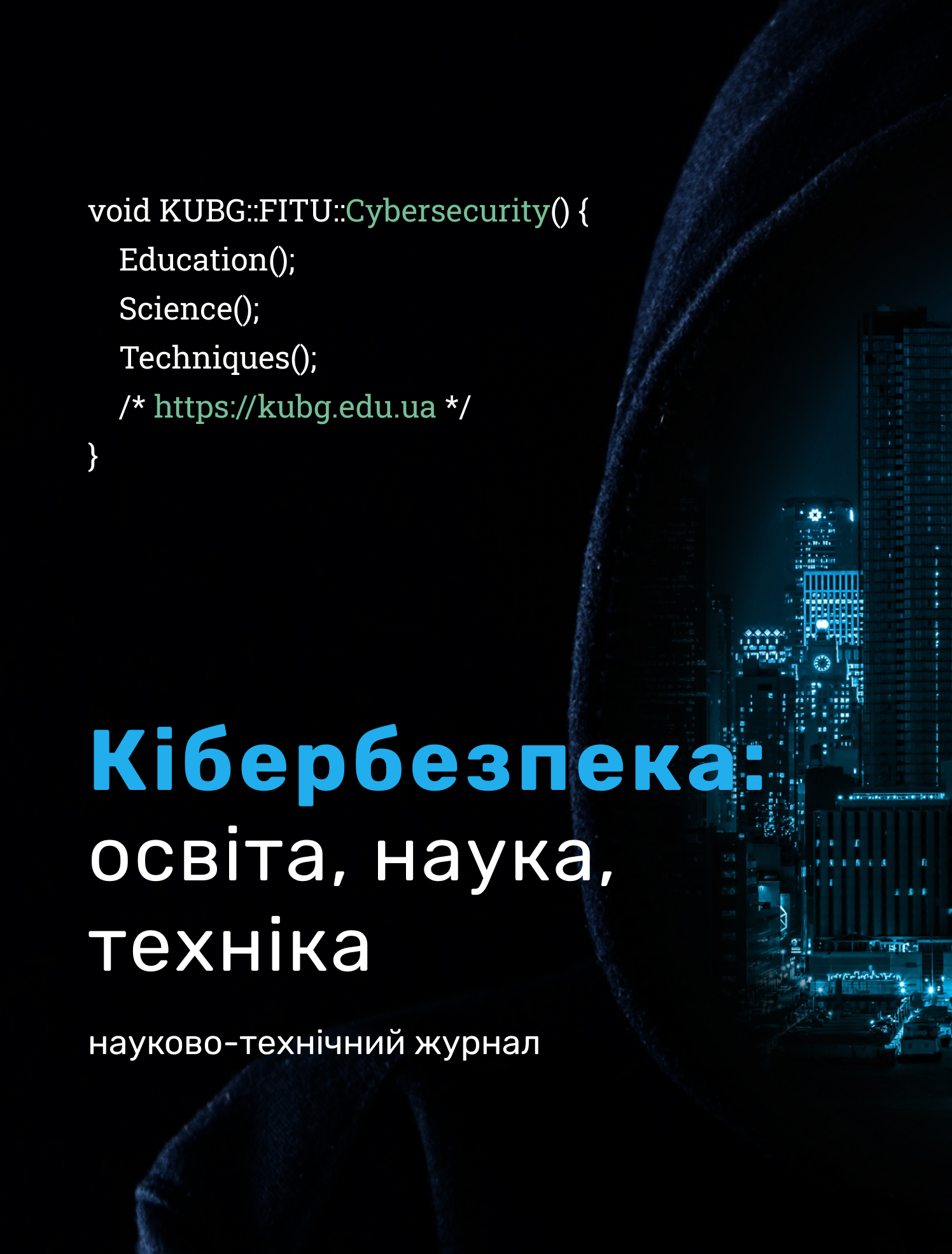МОДЕЛЮВАННЯ ПРОЦЕСІВ ОБРОБКИ ЕКОЛОГІЧНИХ ДАНИХ ДЛЯ СИСТЕМ МОБІЛЬНОГО МОНІТОРИНГУ НА ОСНОВІ БПЛА ТА МЕТОДУ IDW
DOI:
https://doi.org/10.28925/2663-4023.2025.30.955Ключові слова:
БПЛА (Безпілотний Літальний Апарат), IoT-датчики, метод зважених обернених відстаней, інтерполяція, теплокарта, клієнт-серверна архітектураАнотація
У статті розглянуто проблему оперативного екологічного моніторингу радіаційного забруднення в умовах зростання техногенних ризиків. Обґрунтовано доцільність використання безпілотних літальних апаратів (БПЛА), оснащених IoT-сенсорами, як мобільної платформи для збору даних. Запропоновано трирівневу архітектуру системи мобільного моніторингу, що включає модулі збору, обробки та візуалізації даних. Основну увагу приділено розробці алгоритму обробки просторово-розподілених даних, який включає фільтрацію шумів, агрегацію та просторову інтерполяцію методом зважених обернених відстаней (IDW). Проведено моделювання алгоритму на реальних даних, отриманих з БПЛА, та продемонстровано здатність системи генерувати інтерактивні карти забруднення. Робота спрямована на подолання обмежень традиційних підходів і створення науково-методичного апарату для мобільного радіаційного моніторингу.
Завантаження
Посилання
Abramov, V., Astafieva, M., Boiko, M., Bodnenko, D., Bushma, A., Vember, V., Hlushak, O., Zhyltsov, O., Ilich, L., Kobets, N., Kovaliuk, T., Kuchakovska, H., Lytvyn, O., Lytvyn, P., Mashkina, I., Morze, N., Nosenko, T., Proshkin, V., Radchenko, S., … Yaskevych, V. (2021). Theoretical and practical aspects of the use of mathematical methods and information technology in education and science. https://doi.org/10.28925/9720213284km
Platonenko, A., Sokolov, V., Skladannyi, P. ., Anosov, A., & Oleksiienko, H. (2021). Comparison of Modern Technical Means of Air Intelligence to Ensure the Security of the Controlled Zone. Electronic Professional Scientific Journal «Cybersecurity: Education, Science, Technique», 1(13), 170–182. https://doi.org/10.28925/2663-4023.2021.13.170182
Dovzhenko, N., Skladannyi, P., Ivanichenko, Y., & Zhyltsov, O. (2025). A Dynamic Interaction Model of Unmanned Aerial Vehicles with a Sensor Network for Energy-Efficient Monitoring. Electronic Professional Scientific Journal «Cybersecurity: Education, Science, Technique», 3(27), 466–478. https://doi.org/10.28925/2663-4023.2025.27.766
Barabash, O., Ausheva, N., Skladannyi, P., Ivanichenko, Y., & Dovzhenko, N. (2024). Technical Aspects of Building a Fault-Tolerant Sensor Network Infrastructure. Electronic Professional Scientific Journal «Cybersecurity: Education, Science, Technique», 4(24), 185–195. https://doi.org/10.28925/2663-4023.2024.24.185195
Platonenko, A., Sokolov, V. ., Skladannyi, P., & Oleksiienko, H. (2021). Technical Means of Airintelligence to Ensure the Physical Security of Information Activities. Electronic Professional Scientific Journal «Cybersecurity: Education, Science, Technique», 4(12), 143–150. https://doi.org/10.28925/2663-4023.2021.12.143150
Bakharyev, V. S., & Marenych, A. V. (2016). Analytical review of research results on environmental monitoring problems in Ukraine. Ekolohichna bezpeka, (2(22)), 35–42.
Volynets, T. V. (2024). Information systems for mobile monitoring of marine areas and coastal zones. Telekomunikatsiini ta informatsiini tekhnolohii, (4(85)), 53–55.
Trysniuk, V. M., Okhariev, V. O., Trysniuk, T. V., Smetanin, K. V., Holovan, Yu. M., & Kurylo, A. V. (2024). Improvement of the mobile environmental monitoring system. Intellectual Systems for Decision Making and Problems of Computational Intelligence, 178–182.
Trysniuk, V. M., Zorin, D. O., & Volynets, T. V. (2024). Information systems for mobile environmental monitoring of the Dniester Canyon. Telekomunikatsiini ta informatsiini tekhnolohii, (2). https://doi.org/10.31673/2412-4338.2024.027280
Bohaychuk, P., Rudnichenko, M. D., & Otradska, T. V. (2024). Development of an information system for environmental data analysis based on machine learning. Education and Science of Today: Intersectoral Issues and Development of Sciences, Section 18: Information Technologies and Systems, 206–209. http://logos-science.com
Panduman, Y. Y. F., Funabiki, N., Fajrianti, E. D., Fang, S., & Sukaridhoto, S. (2024). A survey of AI techniques in IoT applications with use case investigations in the smart environmental monitoring and analytics in real-time IoT platform. Information, 15(3), 153. https://doi.org/10.3390/info15030153
Veda, P., Ranganathan, C. S., Santhuja, P., Mohankumar, N., Meenakshi, R., & Naganathan, S. B. T. (2024). Aquatic conservation monitoring for river and lake ecosystems with IoT and cloud computing. In Proceedings of the 2024 10th International Conference on Communication and Signal Processing (ICCSP) (pp. 874–879). IEEE. https://doi.org/10.1109/ICCSP60870.2024.10544340
Benmoshe, N. (2024). A simple solution for the inverse distance weighting interpolation (IDW) clustering problem. Sciences, 7(1), 30. https://doi.org/10.3390/sci7010030
Jang, D., Kim, N., & Choo, H. (2024). Kriging interpolation for constructing database of the atmospheric refractivity in Korea. Remote Sensing, 16(13), 2379. https://doi.org/10.3390/rs16132379
Mashkina, I., Nosenko, T., Hlushak, O., Spivak, S., & Bilous, V. (2025). Optimizing Customer Support with AI Chatbots: A Case Study . Electronic Professional Scientific Journal «Cybersecurity: Education, Science, Technique», 4(28), 727–739. https://doi.org/10.28925/2663-4023.2025.28.838
Опубліковано
Як цитувати
Номер
Розділ
Ліцензія
Авторське право (c) 2025 Тетяна Носенко, Ірина Машкіна

Ця робота ліцензується відповідно до Creative Commons Attribution-NonCommercial-ShareAlike 4.0 International License.




